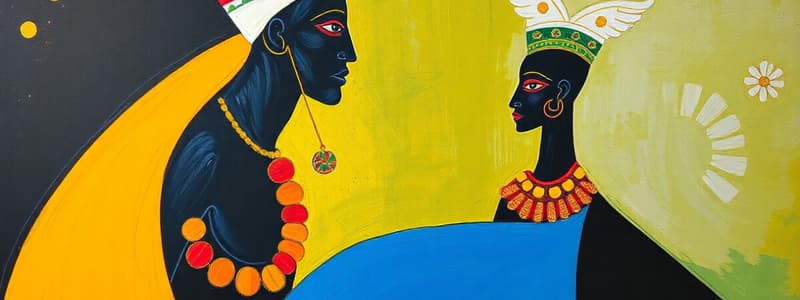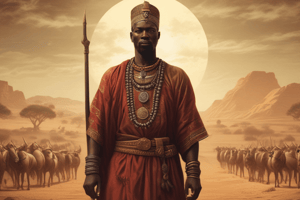Podcast
Questions and Answers
How did the geographical location of the Mali Empire contribute to its economic prosperity?
How did the geographical location of the Mali Empire contribute to its economic prosperity?
- Its location along the coast provided access to international maritime trade routes.
- Its position in a mountainous region allowed for the extraction of rare minerals.
- Its location in the Sahel region facilitated trade between the Sahara and the rainforest regions. (correct)
- Its isolation in a landlocked area protected it from external economic influences.
Which factor most significantly contributed to the decline of the Ghana Empire, paving the way for the rise of the Mali Empire?
Which factor most significantly contributed to the decline of the Ghana Empire, paving the way for the rise of the Mali Empire?
- The conquest by European colonial powers.
- Attacks by the Almoravid Muslims, trade issues, drought, and civil wars. (correct)
- The discovery of new gold mines in South Africa.
- Internal political stability and effective leadership.
Why is the separation between the modern-day country of Mali and the historical Mali Empire important to acknowledge?
Why is the separation between the modern-day country of Mali and the historical Mali Empire important to acknowledge?
- To promote the idea that the modern-day country of Mali is a direct continuation of the Empire.
- To undermine the significance of the Mali Empire's contributions to West African history.
- To avoid conflating their distinct historical trajectories, considering that they are not the same entity. (correct)
- To disregard the influence of the Mali Empire on contemporary Malian culture.
What can be inferred about Sumanguru's trade restrictions on the Malian people?
What can be inferred about Sumanguru's trade restrictions on the Malian people?
What role did Ibn Battuta's writings play in understanding the Mali Empire?
What role did Ibn Battuta's writings play in understanding the Mali Empire?
Which of the following actions by Sundiata Keita contributed MOST significantly to the establishment of the Mali Empire?
Which of the following actions by Sundiata Keita contributed MOST significantly to the establishment of the Mali Empire?
What was a primary economic consequence of Mansa Musa's famous pilgrimage to Mecca?
What was a primary economic consequence of Mansa Musa's famous pilgrimage to Mecca?
How did Mansa Musa's reign influence the cultural landscape of the Mali Empire?
How did Mansa Musa's reign influence the cultural landscape of the Mali Empire?
Which factor contributed MOST to the decline of the Mali Empire after the death of Mansa Musa?
Which factor contributed MOST to the decline of the Mali Empire after the death of Mansa Musa?
Which statement BEST describes the role of oral tradition, specifically through griots, in the Mali Empire?
Which statement BEST describes the role of oral tradition, specifically through griots, in the Mali Empire?
Flashcards
Sundiata Keita
Sundiata Keita
Founder of the Mali Empire in 1235 CE after victory at the Battle of Krina. Established a strong central government and expanded Malian territory.
Manden Charter
Manden Charter
Oral charter of the Mali Empire promoting peace, prosperity, anti-slavery, and education. Passed down through the Malinke people.
Mansa
Mansa
Title for the king of the Mali Empire, with future kings to be from the Keita clan.
Mansa Musa
Mansa Musa
Signup and view all the flashcards
Timbuktu and Gao
Timbuktu and Gao
Signup and view all the flashcards
What was the Mali Empire?
What was the Mali Empire?
Signup and view all the flashcards
Who was Sundiata Keita?
Who was Sundiata Keita?
Signup and view all the flashcards
What is Ibn Battuta's Rihla?
What is Ibn Battuta's Rihla?
Signup and view all the flashcards
What is the Sahel?
What is the Sahel?
Signup and view all the flashcards
What was the Ghana Empire?
What was the Ghana Empire?
Signup and view all the flashcards
Study Notes
- The Mali Empire was a culturally rich, resource-wealthy kingdom in West Africa from the 13th to 17th centuries.
- It was formed by Sundiata Keita, who united smaller kingdoms along the Upper Niger River.
- It is not the same as the modern-day country of Mali.
- Noted for trade networks, education, gold and salt wealth, and the spread of Islam.
- Ibn Battuta's "Rihla" provides much of what is known about the Empire.
Geography
- Primarily in the Sahel region, a transitional zone between the Sahara Desert and rainforests.
- Encompassed parts of modern-day Senegal, Mali, the Gambia, Nigeria, Niger, Chad, Guinea, Mauritania, and Burkina Faso.
Founding
- Sundiata Keita (Lion Prince) established the Empire in 1235 CE.
- Keita united kingdoms after conquering them in West Africa.
- Keita was born into a noble family in the Kangaba region of the Malinke Kingdom, which was part of the Ghana Empire.
- The Ghana Empire (300-1240 CE) predates and was conquered by the Mali Empire.
- The Ghana Empire was weakened by Almoravid attacks, trade issues, decreased gold mining, drought, and civil wars.
- The Kingdom of Sosso took control of a large region of Ghana, but imposed harsh trade restrictions on the Malian people.
- The Malinke tribe rebelled against the Sosso king, Sumanguru.
- Sundiata Keita allied with Malinke chiefs and defeated the Sosso in 1235 CE at the battle of Krina.
- Keita took control of the Ghanaian Empire's capital and its leadership.
- Keita established a strong central government of tribal leaders, chiefs, and powerful merchants.
- Leaders made Keita king (mansa), establishing the Mali Empire.
- Future mansas would be from the Keita clan.
- Sundiata Keita expanded territory with skilled generals and a strong army.
- Local chiefs maintained rule over their communities, but a Malian-appointed governor collected tribute.
Manden Charter
- The Manden Charter was an oral charter passed down through the Malinke people.
- It served as a human rights declaration.
- Advocated for peace, prosperity, anti-slavery sentiments, and education.
- Due to it being oral, it may have changed over time.
- Sundiata Keita died around 1255 and his cause of death is unknown.
Key Facts
- Existed from 1235-1670 CE.
- It was a multi-ethnic and multi-lingual empire.
- Court officials helped run the Empire.
- Important trade location by the Niger River and Sahara Desert routes.
- Traded gold dust for salt from the Sahara.
- Gold and copper mines made the empire wealthy.
- Residents paid yearly tribute and taxes in millet, rice, arrows, etc.
- It was viewed as a fairly progressive empire when it came to values.
- Islam spread through Arab merchants.
- Indigenous animist beliefs were still practiced.
- Used cowrie shells, gold dust, salt, and cotton as currency.
- Griots (storytellers) passed down legends orally.
- Niani, Sundiata Keita's home, was the first capital.
Mansa Musa
- Mansa Musa (king of kings) was the tenth mansa.
- He lived from 1280-1337 CE.
- He was either the grandson of one of Sundiata's brothers, or the grandson of Abu Bakr (the fifth mansa).
- Known for wealth, trade, education, arts, and recognition of West Africa.
- Divided the empire into provinces with appointed governors.
- His hajj to Mecca in 1324 brought knowledge of West Africa to the world.
- He traveled with 60,000 people, including 12,000 slaves/servants.
- Included caravans with silks, camels, exotic animals, gold bars, food and goods.
- He gave gold dust to the poor, which caused the value of gold to drop, especially in Egypt.
- Brought back Muslim scholars, artists, and architects.
- Sanctioned building mosques and educational establishments.
- Developed Timbuktu and Gao as cultural, educational, and religious centers.
- Built renowned libraries, with books still preserved.
- The Grand Mosque in Timbuktu (1327) and the Sankara Madrassa were established
- Musa doubled the size of the Empire with a strong army.
- News of his wealth sparked European interest in finding gold in West Africa.
- Mansa Musa died in 1337 CE and his son Mansa Maghan took the throne.
- Considered the wealthiest person who ever lived, with an estimated net worth of $400 billion.
Timeline
- 1235-1240: Sundiata Keita establishes the Mali Empire after Ghana Empire is conquered.
- 1312-1377: Mansa Musa's rule increases the size of the Empire and makes architectural, educational, and religious contributions.
- 1324: Mansa Musa's hajj to Mecca spreads knowledge of West African wealth.
- 1360-1390: Period of trouble for the Empire with several rulers, later stabilized by a court official.
- 1388: Line of kings descended from Musa dies out, leading to decline due to ineffective leadership.
- 1433: Timbuktu is conquered by Tuareg nomads.
- Mid 1400s-1500: Songhai leaders conquer parts of the Empire.
- 1500: Empire reduced to central Malinke lands.
- 1600: Mali breaks into smaller chiefdoms.
- 1670: Remaining parts are incorporated into the Moroccan Empire.
Fall of the Empire
- Downfall due to poor leadership and family disputes.
- Decline began after the death of Mansa Musa's lineage.
- Trade routes emerged in other locations and were cheaper.
- Europeans began sailing down the west coast of Africa.
- By the mid 1400s, the Songhai Empire took control of Malian lands.
- Remnants of the Empire became small chiefdoms.
- By 1670, the Moroccan Empire conquered and incorporated Malian lands.
- European conquest and colonialism followed.
- The countries of Senegal, Mali, the Gambia, Nigeria, Niger, Chad, Guinea, Mauritania, and Burkina Faso now occupy what was the Malian Empire.
Studying That Suits You
Use AI to generate personalized quizzes and flashcards to suit your learning preferences.




